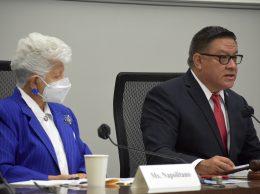Editorial: The region’s political landscape is changing
California’s redistricting commission is about ready to reveal its final plans for drawing congressional maps and two things are becoming crystal clear.
First, House districts for the Tri-Counties will be much more competitive than in the past. Second, Ventura County is paying a political price for the slow-growth policies that have kept population growth in check for the past decade.
First the good news. The so-called “ribbon of shame” that’s kept the 23rd Congressional District a long, skinny and safe one for U.S. Rep. Lois Capps, a Santa Barbara Democrat, will be no more.
The new district, with a population of about 725,000, is likely to include San Luis Obispo and Santa Barbara counties, more or less intact, leaving a district that while it leans Democrat is much more moderate than in the past. It will set up for a hard fought re-election battle for Capps, a popular figure who has been supportive of small business. Whether her opponent is conservative Tom Watson or more moderate former Lt. Gov. Abel Maldonado, it will likely be independent voters, not hard-line party members, who decide who will represent the two counties in Congress.
The bad news is that with a population of about 830,000, Ventura County is too large for one congressional district but far too small to be split into two districts. The most likely scenario is a district that comprises most of the county but slices off Simi Valley or Thousand Oaks — the former for attachment to a Santa Clarita district and the latter for attachment to a West San Fernando Valley representative.
Slicing off Simi Valley would force incumbent Elton Gallegly, R-Simi Valley, to move to Moorpark or Camarillo to keep his House seat. Like Capps, Gallegly is extremely popular and would likely win even in an area that’s much more competitive than the current 24th District.
In a worst-case scenario, a slow-growing Ventura County would fall far behind Los Angeles in overall population growth. Camarillo, Oxnard, Ventura and the Heritage Valley would be divided up piecemeal and become political pawns in the slice-and-dice politics of Southern California.
The bottom line is that if Ventura County politicians want to have more powerful leaders in Congress, they’ll have to envision policies that allow Ventura County’s population to grow steadily so that by mid-century the county can claim a second House seat. That presents quite a unique challenge to Supervisors Linda Parks and Steve Bennett, whose limited-growth policies may have actually reduced Ventura County’s ability to steer its own future.










